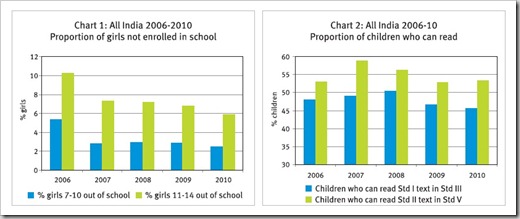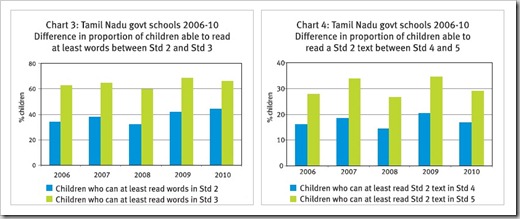Everyone talks about the Right to Education Act these days. It seems to have become the most important policy decision for our government. Obviously it doesn’t have the power to overthrow a government like say talking about terrorism, reservation for specific sectors of the society etc. But in a period where everyone from the common man to NGOs is putting deep pressure on the government, they obviously can’t let this issue be at the backburner.
For years the abysmal student involvement in schools across the country had been a humungous problem. The number of students who attend school today has shot up to 96%. Already happy? WAIT! The question is how many of them come to school for studying.
According to Annual Status of Education Report (Rural) 2010, The number has reached 96% not because the standards of schools and infrastructure has improved by leaps and bounds, but because there are other factors like mid day meals to go along with it. Obviously, if you don’t have anything to eat, how will you study? But here it may be that people eat good food rather than study. [full report pdf]
Enrolments from Bihar to Gujarat have risen magnanimously. Bihar is a case in point because of its high levels of poverty and not much importance being given to education over the years. The out of school share ratio of girls x`has come down to just 4.6%. More than 63% of the children in the age group of 6-14 attend school today. This number has increased significantly in rural areas too. Continuing with the survey, they have also found a higher enrolment rate across South India compared to the other parts.

But does enrolment guarantee success? During the earlier years the target was getting maximum students to come to school. But sadly along with that our government failed to provide the basic infrastructure in terms of blackboards, proper classrooms, teachers who come regularly and also desks and chairs. This has resulted in the quality of education falling to abysmal levels.
Students who can’t read standard 1 text in standard 2 text in standard 5 has dropped around 5% in 5 years. People in standard 5 cannot even do basic calculations the kinds one does in standard 1 and standard 2.

With such pathetic standards of education, where are we moving to? Everyone cried out saying that one can’t fail students in lower classes. But does this mean that you keep promoting the students despite getting basic competencies in English and Maths. Shocking!

The survey also analysed the schools across the country on 7 basic parameters like toilets for both males and females, presence of teachers, drinking water etc. Only 3% of them had all these facilities.
The Activity Based Learning Program in Tamil Nadu seems to have made a positive change to education. While across the nation, only 50% in Class VIII can solve their level Maths questions, 69% Biharis can solve those kind of questions.
The most important factors to be considered in the future for education include having good classrooms, ensuring teachers are present, continuously evaluating different forms of education like the Activity Based Learning Program in Tamil Nadu and equipping schools. Both qualitative and quantitative improvements are required in equal amounts.
Do we want Right to Education just to remain as a RIGHT?
